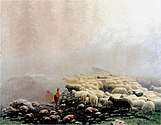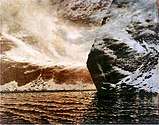Stanisław Witkiewicz
Stanisław Witkiewicz (Lithuanian: Stanislovas Vitkevičius) (8 May 1851 – 5 September 1915[1]) was a Polish painter, art theoretician, and amateur architect, known for his creation of "Zakopane Style".[2][3]

Life
Witkiewicz was born in Pašiaušė (Polish: Poszawsze) in Samogitia,[1] present-day Lithuania, in the lands of the partitioned Polish-Lithuanian Commonwealth, ruled at the time by the Russian Empire.
As an adolescent, he spent several years in Siberian Tomsk, where his parents and two older siblings were exiled for their support of the January Uprising.[1] He studied at the Academy of Fine Arts in Saint Petersburg (1868–1871) and furthered his studies in Munich (1872–1875). During his stay in Munich, he befriended painters Aleksander Gierymski, Józef Chełmoński and Henryk Siemiradzki.[1]
In 1875, he moved to Warsaw and set up a painting workshop in the laundry at the Hotel Europejski. In 1884, he married Maria Pietrzkiewicz. The pair had a son, Stanisław Ignacy.[1] The son's godmother was the internationally famous actress Helena Modjeska, whom the elder Witkiewicz in 1876 had nearly accompanied to California in the United States.
In 1884–1887, Witkiewicz worked as the artistic director of "Wędrowiec" weekly, for which he wrote a series of articles concerning the values of a work of art and the role of art critics (published in book form under the title "Painting and criticism among us", Sztuka i krytyka u nas, in 1891 and 1899). In 1887, he held the same position in "Kłosy" magazine.[1]
In 1886, he visited Zakopane for the first time. He developed a fascination with the mountains, the Podhale highlanders and their vernacular traditions. His ambition became to create a Polish national style through extraction of all-Polish forms from the architectural and decorative art of the highlanders.[4][1]
He formulated the Zakopane Style (styl zakopiański) (also known as Witkiewicz Style (styl witkiewiczowski)) in architecture,[5] in which he designed homes and interiors for well-off, artistically inclined Poles.[3] He was strongly associated with Zakopane and promoted it in the art community.
Witkiewicz had strong views against formal education: "school is completely at odds with the psychological make-up of human beings". He applied this principle in his son's upbringing and was disappointed when the 20-year-old Witkacy chose to enroll at the Academy of Fine Arts in Kraków.
In 1908, suffering from tuberculosis, the elder Witkiewicz left his family in Zakopane and relocated to Lovran, a fashionable resort in what was then Austria-Hungary, which today is in Croatia. He died there in 1915.
His first monographic art exhibition was staged in Zachęta Fine Arts Society in 1927.[1] His son, Stanisław Ignacy Witkiewicz, became a famous painter, playwright, novelist and philosopher, also known (from the conflation of his surname and middle name) by the pseudonym "Witkacy."
Selected publications
- "Policja a sztuka" ["The police and art"] (1902),
- "Chrześcijaństwo i katechizm. O nauce religii w szkołach galicyjskich" ["Christianity and the catechism. About the teaching of religion in Galician schools"] (1904),
- "Wallenrodyzm czy znikczemnienie" ["Wallenrod-ism or becoming ignoble"] (published in "Kultura Polski" 1917, a fragment of the work "Studium o duszy polskiej po 1863 roku" ["A study of the Polish soul after 1863"],
- "Przełom" ["Turning point"],
- "Życie, etyka i rewolucja" ["Life, ethics and revolution"],
- "Na przełęczy. Wrażenia i obrazy z Tatr" ["On the mountain pass. Impressions and images from the Tatra mountains"] (1891, first published in "Tygodnik Ilustrowany" 1889–1890),
- "Po latach" ["Years later"] (1905),
- "Z Tatr" ["From the Tatra mountains"] (1907),
- Monographs: "Juliusz Kossak" (1900), "Aleksander Gierymski" (1903), "Matejko" (1908).
Selected paintings
See also
- List of Poles
- Bronisław Linke
References
- Kossowska, Irena. "Stanisław Witkiewicz". culture.pl. Adam Mickiewicz Institute. Retrieved 23 April 2019.
- Guile, Carolyn C. (2015). "Circulations: Early Modern Architecture in the Polish-Lithuanian Borderland". In DaCosta Kaufmann, Thomas; Dossin, Catherine; Joyeux-Prunel, Béatrice (eds.). Circulations in the Global History of Art. Routledge. p. 89. ISBN 978-1472454560.
- Crowley, David (Spring 1995). "The Uses of Peasant Design in Austria-Hungary in the Late Nineteenth and Early Twentieth Centuries". Studies in the Decorative Arts. University of Chicago Press. 2: 9–11, 19.
- Edyta Barucka (2010). "Redefining Polishness: The Revival of Crafts in Galicia around 1900". Acta Slavica Iaponica. 28: 83, 86.
- See picture in Polish article on styl zakopiański
External links
| Wikimedia Commons has media related to Stanisław Witkiewicz (1851-1915). |
- Works by or about Stanisław Witkiewicz at Internet Archive
- Works by Stanisław Witkiewicz at Open Library

- Stanisław Witkiewicz at Culture.pl



